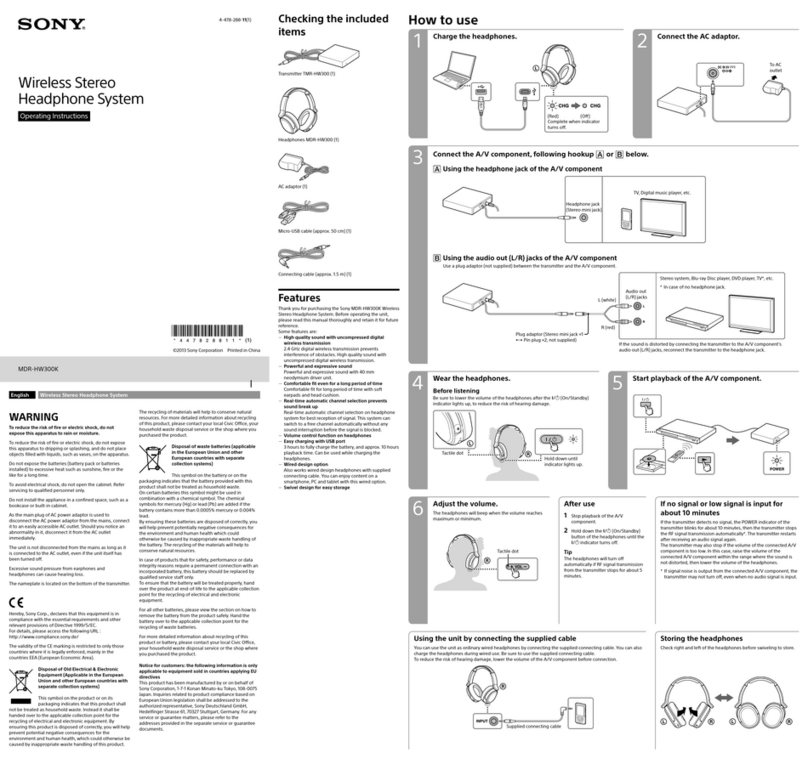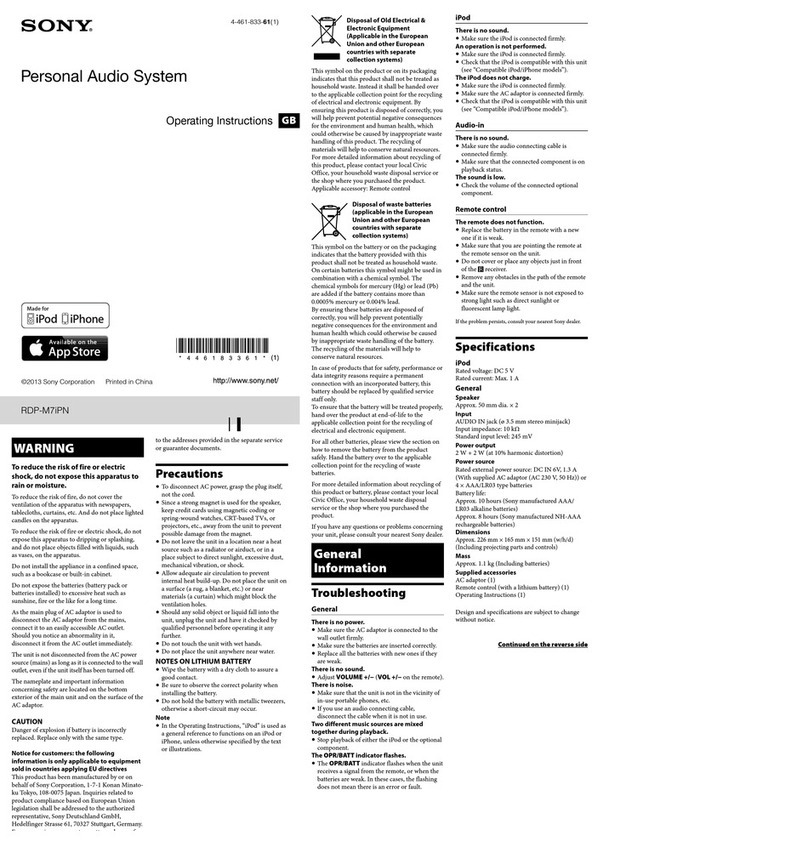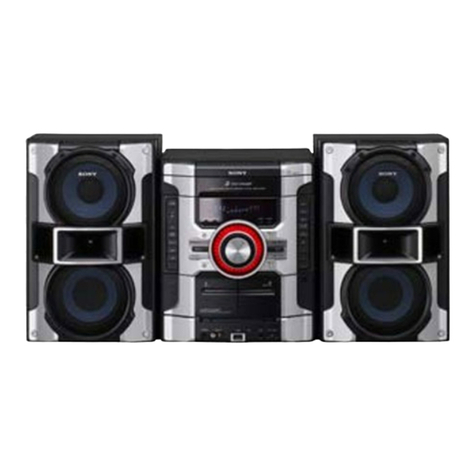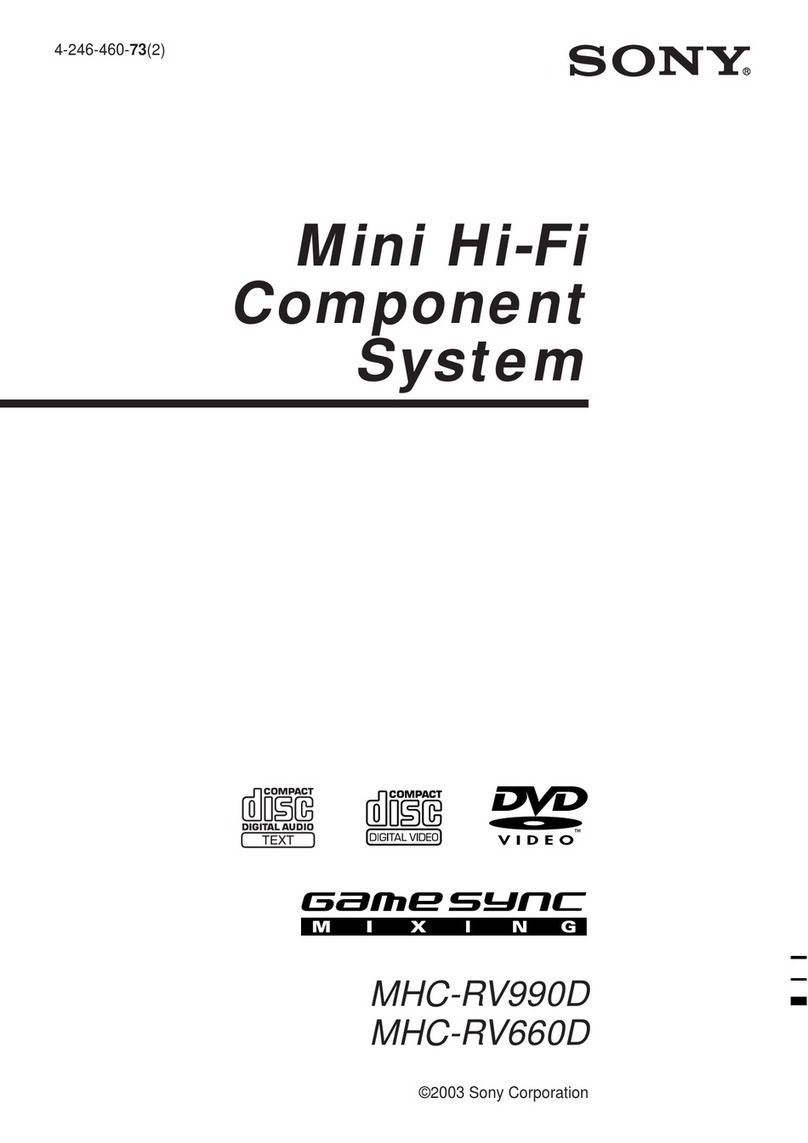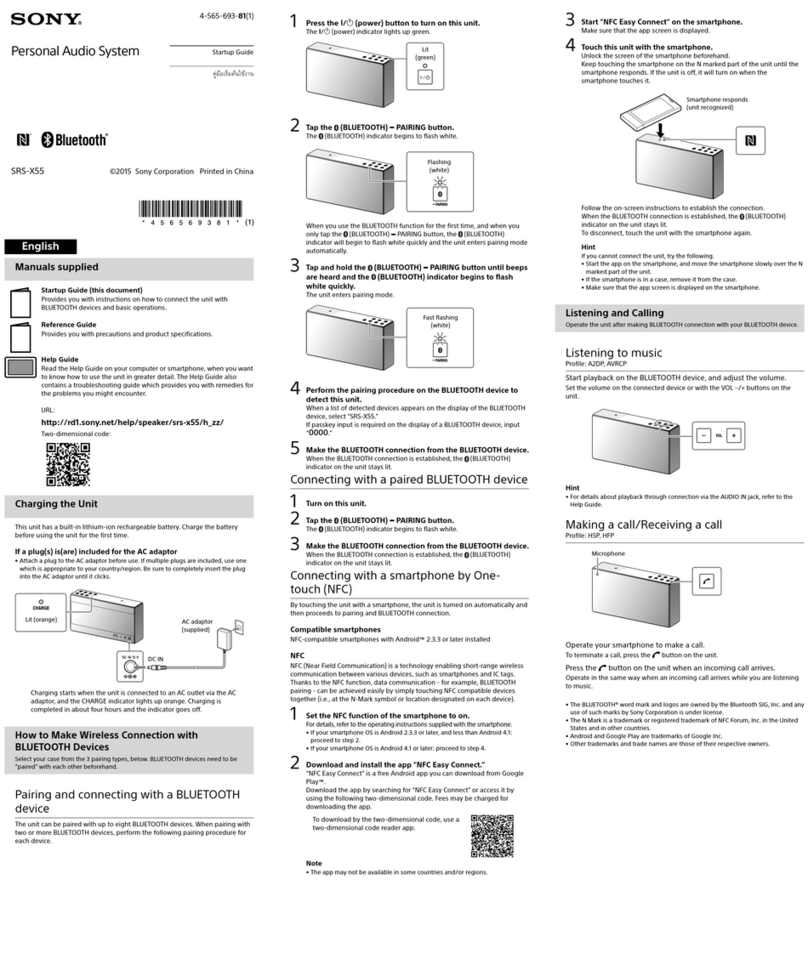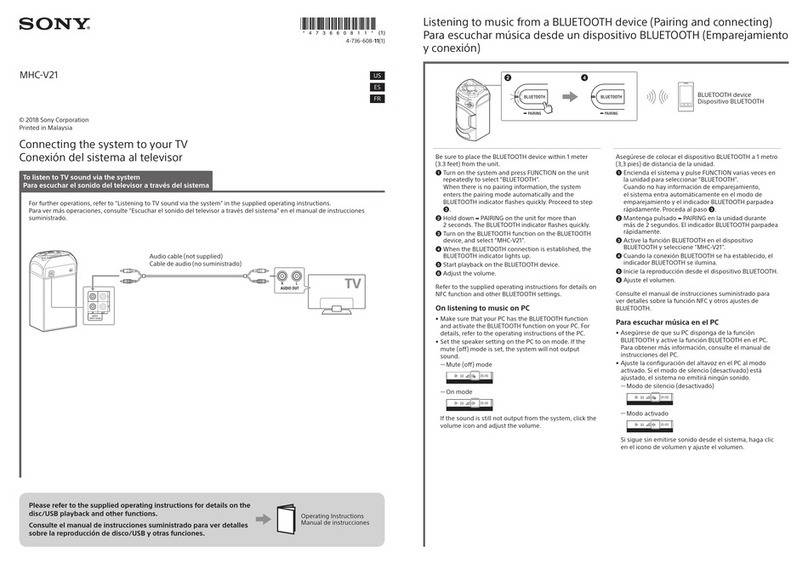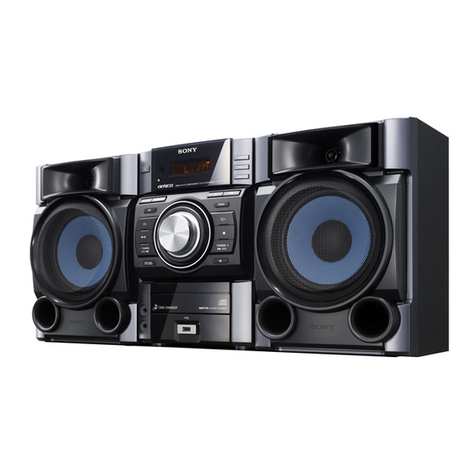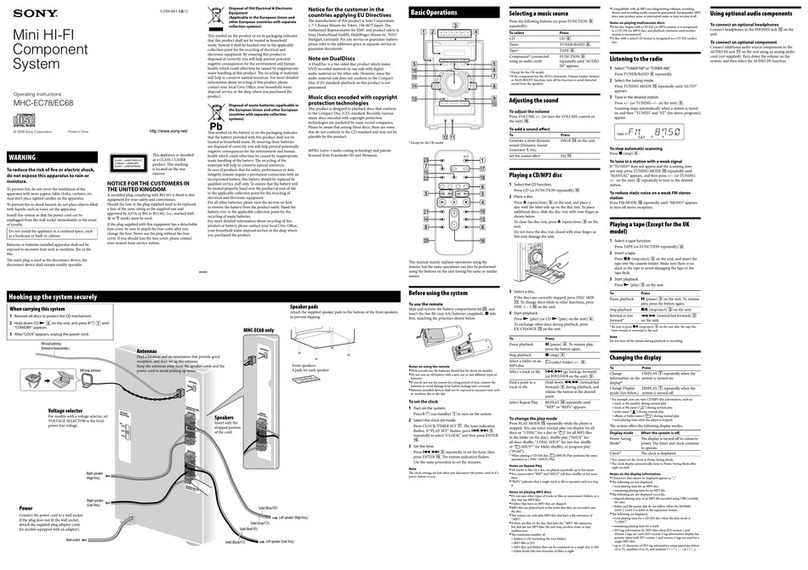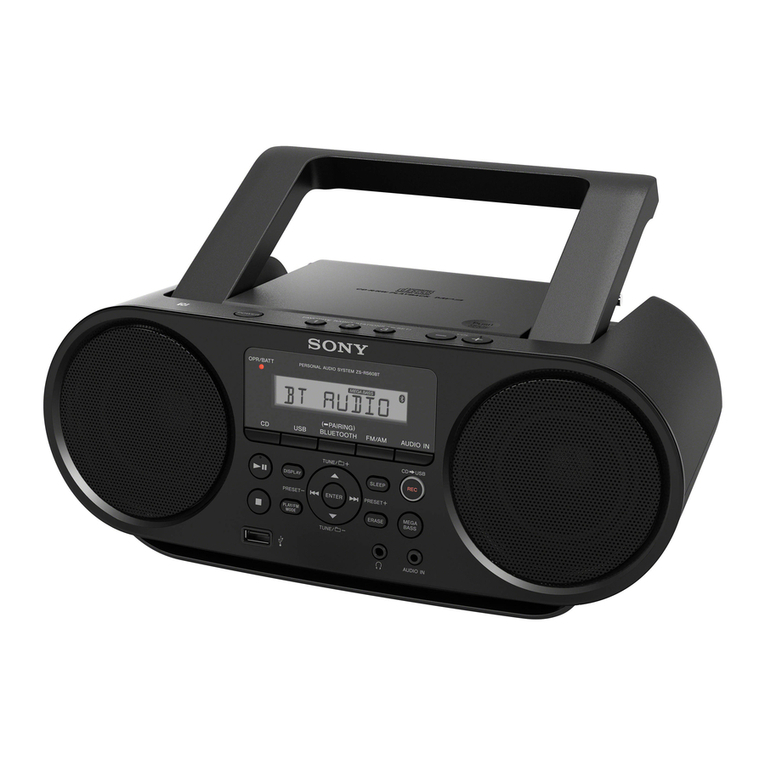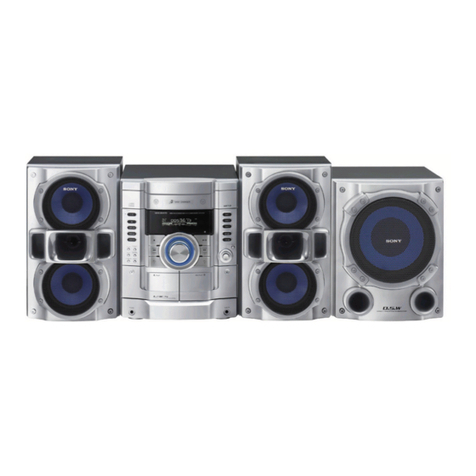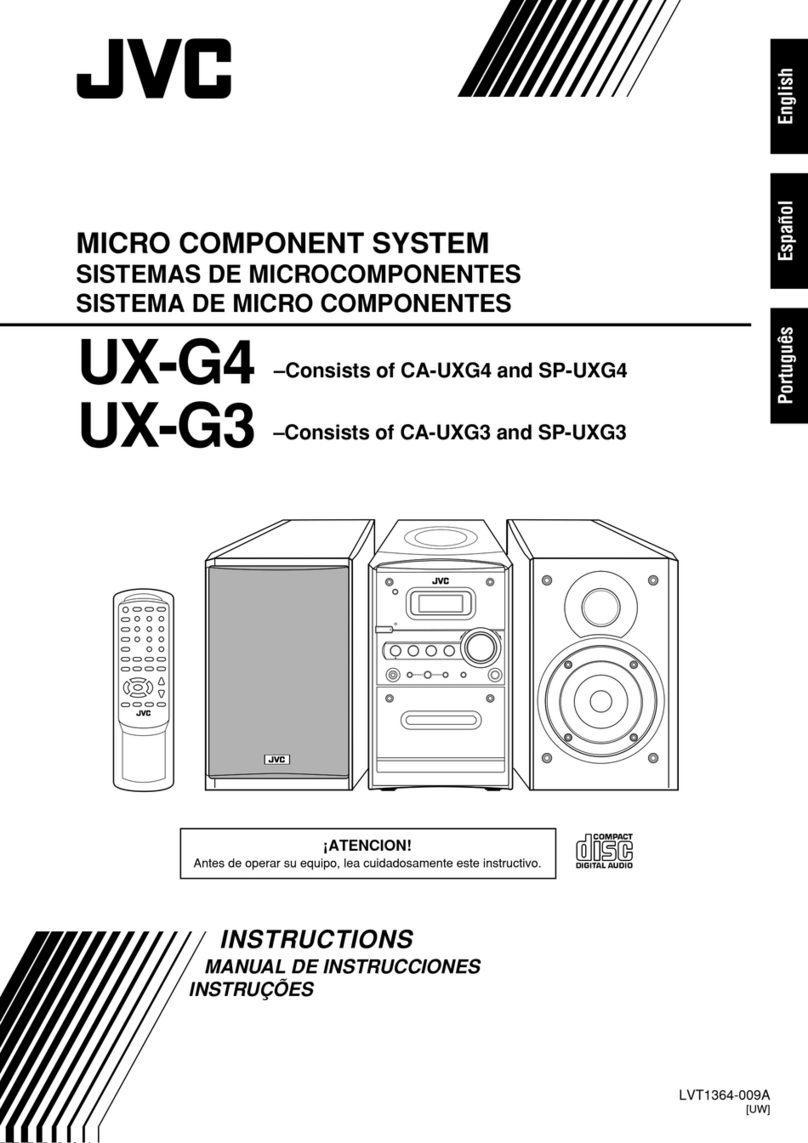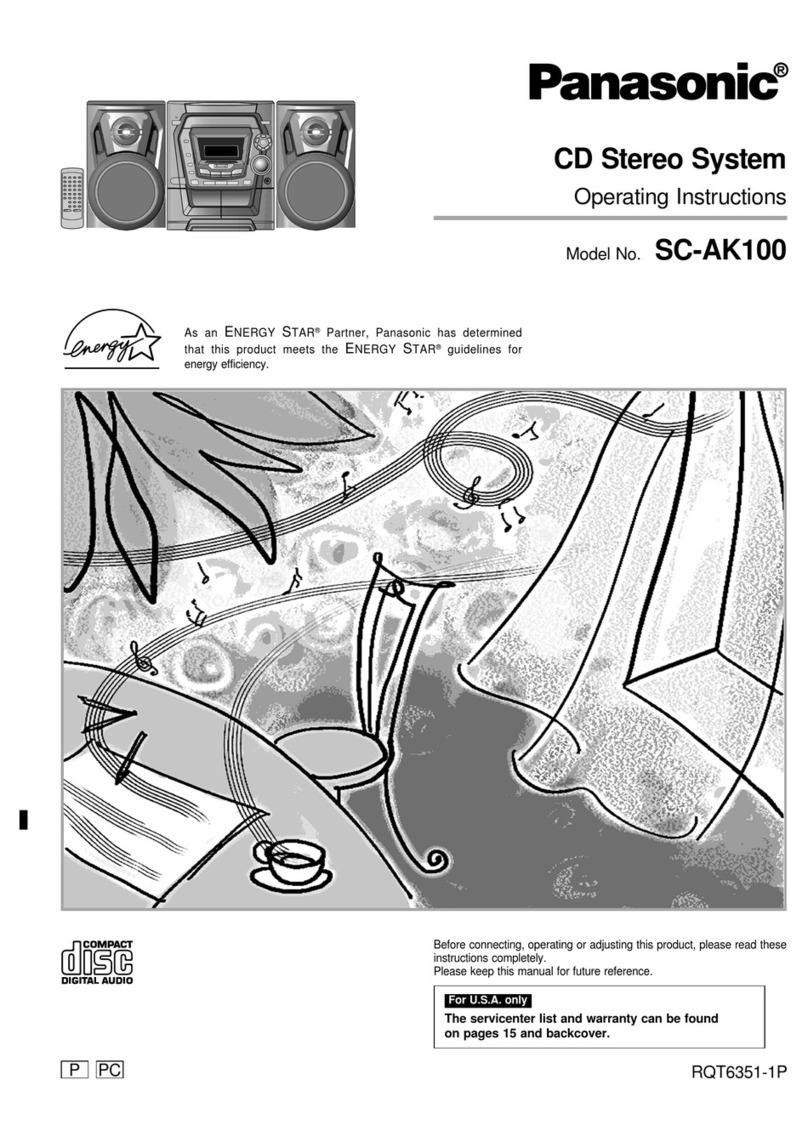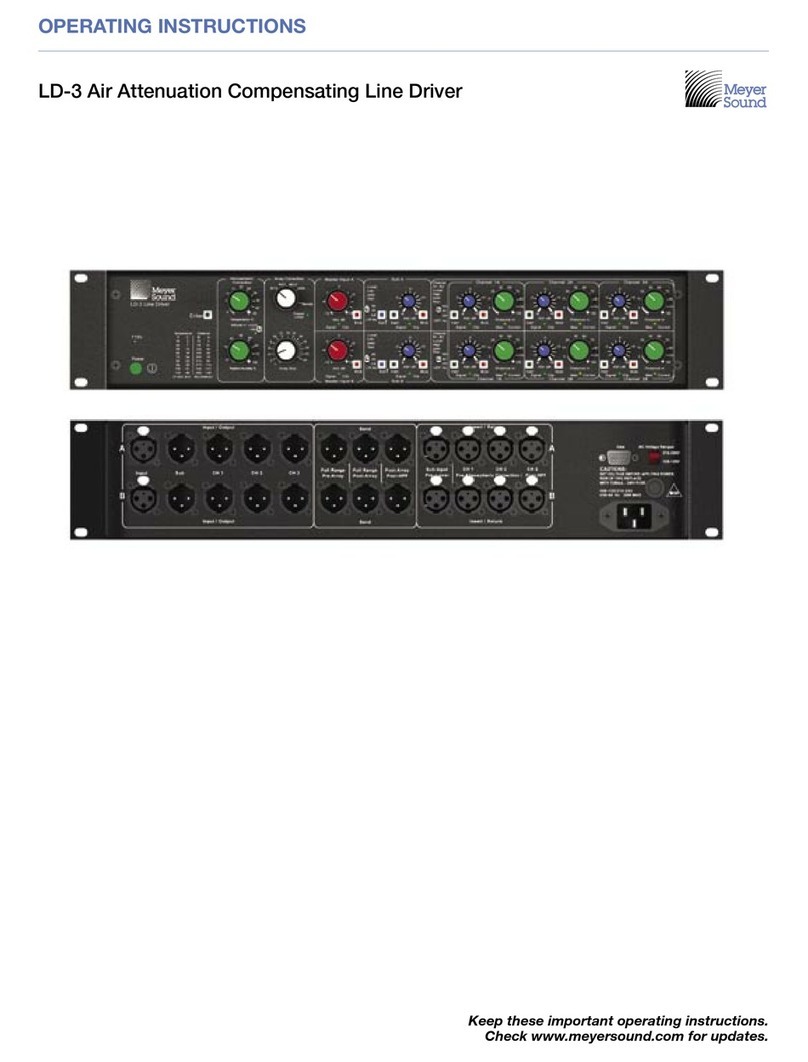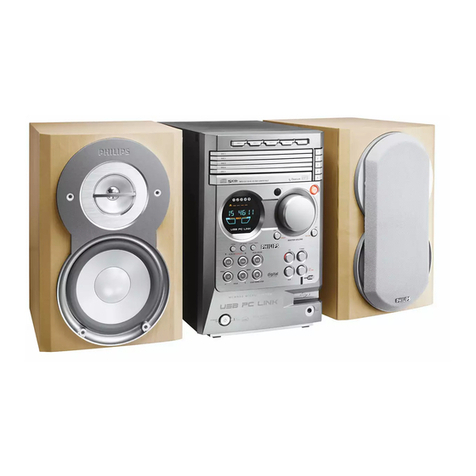
Español Sistema de audio personal
Para consultar la información relacionada al número del certificado, refiérase a la etiqueta del
empaque y/o del producto.
ADVERTENCIA
Para reducir el riesgo de incendio o descarga eléctrica, no exponga este adaptador USB
de CA a la lluvia ni a la humedad.
Para reducir el riesgo de incendio, no cubra los orificios de ventilación del aparato con periódicos,
manteles, cortinas, etc.
No exponga el aparato a fuentes de llama abierta (por ejemplo, velas encendidas).
Para reducir el riesgo de incendio o descarga eléctrica, no exponga este adaptador USB de CA al
agua en forma de gotas o salpicaduras y no coloque objetos llenos de líquido, como vasos, en el
adaptador USB de CA.
No sitúe el aparato en un espacio cerrado, como una estantería o un armario empotrado.
No exponga las baterías (el paquete de baterías o las baterías instaladas) a un calor excesivo como
el sol directo, fuego o similar durante un período prolongado.
Como el enchufe principal del adaptador USB de CA se utiliza para desconectar el adaptador USB
de CA de la red eléctrica, conéctelo a un tomacorriente de CA de fácil acceso. Si detecta algo
anormal en el enchufe, desconecte de inmediato la unidad de la toma de corriente de CA.
La unidad no estará desconectada de la fuente de alimentación de CA (toma de corriente) mientras
esté conectada a la toma de pared, aunque esté apagada.
Si su piel entra en contacto con el adaptador USB de CA o este producto por un tiempo prolongado
cuando está encendido, puede causar una lesión por temperatura baja.
Precauciones
A tener en cuenta cuando se utiliza con un teléfono móvil
Si desea obtener más información sobre el funcionamiento del teléfono móvil cuando se recibe
una llamada telefónica mientras se transmite el sonido mediante la conexión BLUETOOTH,
consulte el manual de instrucciones suministrado con el teléfono móvil.
Seguridad
La etiqueta y la información importante relacionada con la seguridad se encuentran en la parte
inferior del exterior de la unidad principal y en la superficie del adaptador USB de CA.
Antes de utilizar el sistema, asegúrese de que el voltaje de funcionamiento del sistema es
idéntico al del suministro eléctrico local.
Establecimiento de adquisición Voltaje de funcionamiento
Todos los países/todas las regiones De 100 V a 240 V de CA, 50 Hz/60 Hz
Notas sobre el adaptador USB de CA
Cuando conecte o desconecte el adaptador USB de CA, apague el sistema de antemano. De no
ser así, puede provocar un mal funcionamiento.
Utilice solamente el adaptador USB de CA y el cable micro-USB suministrados. Para evitar daños
en el sistema, no utilice otro adaptador USB de CA.
Polaridad del puerto USB del
adaptador USB de CA
Enchufe el adaptador USB de CA a un tomacorriente cercano (red eléctrica). En caso de que haya
algún problema, desconéctelo del tomacorriente de pared (red eléctrica) de inmediato.
No instale el adaptador USB de CA en un espacio cerrado, tal como una biblioteca o un armario
empotrado.
Para disminuir el riesgo de incendio o electrochoque, no exponga el adaptador USB de CA a
salpicaduras ni goteos y no coloque objetos que contengan líquidos, tales como floreros, sobre el
adaptador USB de CA.
Ubicación
No coloque el altavoz en una posición inclinada.
No deje el sistema cerca de fuentes de calor, ni en lugares expuestos a la luz solar directa, polvo
excesivo, humedad, lluvia o golpes mecánicos.
Funcionamiento
No inserte ningún objeto pequeño, etc., en las tomas de corriente ni en los orificios de ventilación
de la parte posterior del sistema. Es posible que el sistema sufra un cortocircuito o un fallo de
funcionamiento.
Limpieza
No utilice alcohol, bencina ni disolventes para limpiar la unidad.
Otros
Se necesitan dos unidades para utilizar la función para agregar altavoces. Sólo el códec SBC es
compatible con la función para agregar altavoces.
Si desea realizar alguna consulta o solucionar algún problema relacionado con este sistema que
no se trate en este manual, póngase en contacto con el distribuidor Sony más cercano.
Acerca de los derechos de autor
LDAC™ y el logotipo LDAC son marcas comerciales de Sony Corporation.
La marca denominativa BLUETOOTH® y sus logotipos son propiedad de Bluetooth SIG, Inc. y Sony
Corporation los utiliza bajo licencia.
N Mark es una marca comercial o una marca comercial registrada de NFC Forum, Inc. en los
Estados Unidos y en otros países.
Las demás marcas y nombres comerciales pertenecen a sus respectivos propietarios.
Notas sobre la característica de impermeabilidad
(leer antes de usar el sistema)
Impermeabilidad del sistema
Este sistema cuenta con una especificación de impermeabilidad *1,*2de IPX5*3que se especifican
en “Grados de protección frente a la penetración del agua” de “Grados de protección de ingreso
(Código IP)” IEC60529. Sin embargo, no es completamente impermeable.
No deje caer el sistema en el agua caliente de una bañera ni lo use intencionadamente en el agua.
En función del uso, si el agua se filtra en el sistema puede provocar un incendio, una descarga
eléctrica o un fallo de funcionamiento.
Utilice el sistema con pleno conocimiento de lo siguiente:
Líquidos aplicables a las especificaciones de impermeabilidad
Aplicable: agua dulce, agua corriente, sudor
No aplicable: todos los demás líquidos (agua jabonosa, agua con detergente o
agentes de baño, champús, agua de manantial, agua caliente, agua
de piscina, agua de mar, etc.)
*1Requiere que la cubierta esté bien cerrada.
*2Los accesorios suministrados no son impermeables.
*3IPX5 (Grado de protección frente a chorros de agua): Se ha probado y se ha comprobado que el
sistema continúa en funcionamiento después de la exposición directa a los chorros de agua de
una boquilla de 6,3 mm (aproximadamente /pulg.) de diámetro interno desde cualquier
dirección, con una aplicación de aproximadamente 12,5 L/min de agua durante más de 3
minutos desde una distancia aproximada de 3 metros (aproximadamente 10pies).
La impermeabilidad del sistema se basa en nuestras mediciones bajo las condiciones descritas
en este documento. Tenga en cuenta que la garantía no cubre los fallos de funcionamiento
causados por la inmersión en agua como consecuencia de un uso inadecuado por parte del
cliente.
Para evitar el deterioro de la impermeabilidad
Controle lo siguiente y utilice el sistema correctamente.
No coloque ni deje el sistema en lugares extremadamente fríos o extremadamente calientes
(temperaturas fuera del rango de los 5 °C – 35 °C (41 °F – 95 °F)). Si usa o deja el sistema en
lugares con temperaturas fuera del rango antes mencionado, puede que este deje
automáticamente de proteger los circuitos internos.
Tenga cuidado de no dejar caer el sistema y evite someterlo a golpes. Las deformaciones o los
daños podrían deteriorar la impermeabilidad.
No use el sistema en lugares donde pueda salpicarse con grandes cantidades de agua o agua
caliente. El sistema no cuenta con un diseño que sea resistente a la presión del agua. El uso del
sistema en una ubicación como la mencionada anteriormente puede causar un fallo de
funcionamiento.
No vierta agua caliente ni sople aire caliente con un secador de pelo, ni con ningún aparato
similar, directamente sobre el sistema. Además, no use el sistema en lugares con altas
temperaturas como saunas ni cerca de estufas.
Manipule la cubierta cuidadosamente. La cubierta cumple un papel muy importante en el
rendimiento de la impermeabilidad. Cuando utilice el sistema, asegúrese de que la cubierta esté
completamente cerrada. Cuando cierre la cubierta, asegúrese de no dejar objetos extraños
dentro. Si la cubierta no se cierra completamente, la impermeabilidad podría verse afectada y
esto podría producir fallos en el funcionamiento del sistema como resultado de la penetración
del agua en el sistema.
Cubierta
Cómo proceder cuando el sistema se moja
Si el sistema se moja, primero retire el agua del sistema y luego seque la humedad adherida al
sistema con un paño suave y seco. Especialmente en las regiones frías, si no se retira la humedad
de la superficie, es posible que el sistema se congele y provoque un fallo de funcionamiento.
Asegúrese de secar la humedad después de utilizar el sistema.
Coloque el sistema sobre una toalla o paño seco. Luego déjelo a temperatura ambiente y séquelo
hasta que no queden restos de humedad.
Especificaciones
Sección del altavoz
Altavoz del sistema Aprox. 42 mm de diámetro × 2
Tipo de gabinete Modelo de radiador pasivo
BLUETOOTH
Sistema de comunicación
Especificación BLUETOOTH versión 3.0
Salida Especificación BLUETOOTH Clase de potencia 2
Rango de comunicación máximo
Línea de vista de aprox. 10 m (30 pies)*1
Banda de frecuencia Banda de 2,4 GHz (2,4000 GHz - 2,4835 GHz)
Método de modulación
FHSS
Perfiles BLUETOOTH compatibles*2
A2DP (Advanced Audio Distribution Profile)
AVRCP (Audio Video Remote Control Profile)
HSP (Headset Profile)
HFP (Hands-free Profile)
Códecs compatibles*3
SBC*4, AAC*5, LDAC*6
Intervalo de transmisión (A2DP)
20 Hz - 20 000 Hz (frecuencia de muestreo de 44,1 kHz)
*1El alcance real varía según factores como obstáculos entre dispositivos, campos magnéticos
alrededor de un horno microondas, electricidad estática, sensibilidad de recepción, desempeño
de la antena, sistema operativo, aplicaciones de software, etc.
*2Los perfiles estándar de BLUETOOTH indican el propósito de la comunicación BLUETOOTH entre
dispositivos.
*3Códec: Compresión de señal de audio y formato de conversión
*4Códec de sub-banda
*5Codificación de audio avanzada
*6LDAC es una tecnología de codificación desarrollada por Sony para activar la transmisión del
contenido de Audio de alta resolución (Hi-Res), incluso a través de una conexión BLUETOOTH. A
diferencia de otras tecnologías de codificación compatibles con BLUETOOTH, como SBC,
mantiene la calidad del contenido de audio de alta resolución (Hi-Res)*, permitiendo la
transmisión de datos a través de una conexión inalámbrica BLUETOOTH con una calidad de
sonido sin precedentes y un tamaño aproximadamente tres veces mayor* que otras tecnologías
gracias a una codificación eficiente y un sistema de paquetes optimizado.
*7Excluye contenidos con formato DSD.
*8En comparación con SBC (Codificación sub-banda), cuando se selecciona la velocidad de bits de
990 kbps (96/48 kHz) o 909 kbps (88,2/44,1 kHz).
Micrófono
Tipo Condensador de electreto
Características de dirección
Omnidireccional
Rango de frecuencia efectivo
100 Hz - 7 000 Hz
General
Entrada Toma AUDIO IN (minitoma estéreo de ø 3,5 mm)
Potencia CC 5 V (usando el adaptador USB de CA suministrado conectado a CA 100 V
- 240 V, fuente de alimentación de 50 Hz/60 Hz) o usando una batería de
iones de litio incorporada
Adaptador de CA (AC-UUD12)
ENTRADA: CA 100 V - 240 V, 50 Hz/60 Hz, 0,2 A
SALIDA: CC 5 V, 1,5 A
Vida útil de la batería de ion-litio (cuando se utiliza la conexión BLUETOOTH)
Aproximadamente 12 horas*9
Dimensiones (incluyendo piezas proyectadas y controles)
Aprox. 191 mm × 62 mm × 65 mm (an./al./p.)
Peso Aprox. 480 g batería incluida
Accesorios suministrados
Adaptador USB de CA (AC-UUD12) (1)
Cable micro-USB (1)
Manual de instrucciones (1)
Guía de referencia (este documento) (1)
*9Cuando la fuente de audio especificada se utiliza, y el nivel de volumen de la unidad se ajusta a
10.
Si el nivel de volumen de la unidad se ajusta al máximo, la vida útil será de aprox. 3 horas.
El tiempo puede variar, dependiendo de la temperatura o las condiciones de uso.
El diseño y las especificaciones pueden ser cambiadas sin previo aviso.


